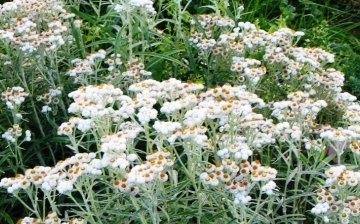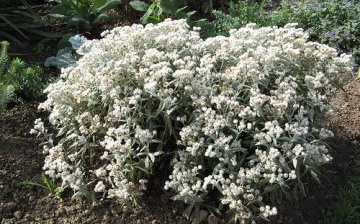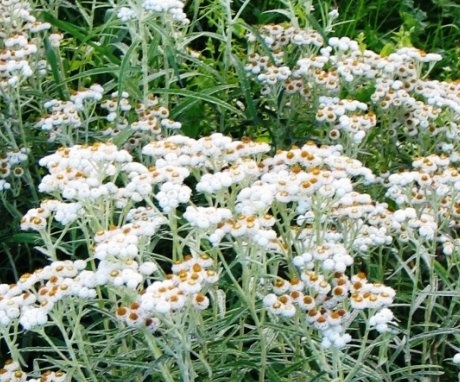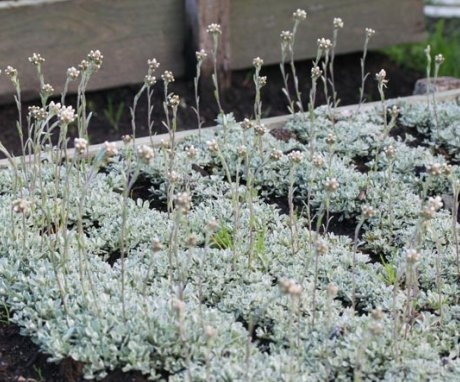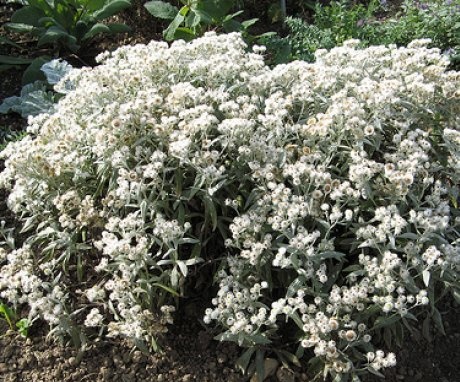Anafalis: care, cultivation and use on the site
Anafalis is a perennial plant familiar to gardeners, which has become widespread due to its beautiful flowers. The genus Anafalis has more than 35 species of plants, but Anafalis pearl, which has white lush inflorescences, remains the most common for central Russia. It is very easy to grow it in a flowerbed, and it can be an excellent decoration for the site.
Content
- Origin, properties and appearance
- Growing anaphalis: basic requirements
- The use of anaphalis for decorative purposes
Origin, properties and appearance
Anaphalis originates from East Asia, 12 species grow on the territory of the CIS today. Also, this plant is found in the temperate latitudes of Europe and North America, it easily tolerates frost and is very resistant to drought.
Anafalis is generally distinguished by its unpretentiousness, so it will not be difficult to grow it in a flower bed.
This plant has been grown for many years, not only as decorative... It has long been used in folk medicine and even shamanic practices, and today it is used in homeopathy. It is believed that inflorescence infusion has a healing effect, it is also used as an expectorant.
Various decoctions and tinctures are prepared from pearl anaphalis, which can be used as a laxative and emetic.
Outwardly it is:
- Tall herbaceous plant.
- The length of the stems can reach half a meter, however, more often low-growing varieties with a height of 20-30 cm are grown.
- In anaphalis pearl, the stem is covered with white hairs along its entire length, giving the plant an interesting shade, thanks to which this species received its name.
- The leaves have an elongated lanceolate shape, in the upper part they branch out.
- On the inside, the leaves have a grayish tint.
- At the top of the stems, corymbose inflorescences with small white flowers are formed.
- Anaphalis flowers are odorless, they look very unusual due to a basket of dry petals.
- In the middle of the inflorescence there are small tubular yellow flowers.
- The buds appear from June to September, the plant can bloom for a very long time.
- One of the features of anaphalis is a powerful rhizome, which quickly gives off lateral shoots.
Because of this, the plant is very resistant to weeds and can become a real protector for a flower bed.
Every year the length of the rhizome increases by 30 cm, so its growth is artificially limited with the help of metal fences dug into the sides of the flower bed.
Growing anaphalis: basic requirements
In general, this plant remains very undemanding, so it can be planted in both well-lit and shaded areas, however, it still loves sunny places more.
You can achieve rapid growth and abundant flowering if you follow several principles when growing:
- For this plant, a poor sandy loam soil is desirable, since it does not like excess moisture. Any soil will do, however, as long as there is good drainage so that the water does not stagnate. This is an almost ideal solution for areas with poor soil, where it is difficult to grow other decorative species.
- Frequent watering is not necessary.The plant, thanks to its powerful rhizome, is able to withstand even severe drought. It is enough to water the flower bed every few days with a hose to ensure a quick start of flowering. Overmoistening should not be allowed, as in this case, soaking will begin: the roots rot, and the leaves begin to crumble.
- Feeding anafalis is not required, however, it is recommended to dig up the soil well before planting and add some compost fertilizer.
Anafalis can be propagated by cuttings:
- Cutting is used more often, since in this case young shoots can be obtained faster.
- It is held from May to October; cuttings 5-7 cm long are selected for rooting.
If the soil is too dense, you can add a little sand to it so that the water does not stagnate.
- Cuttings are planted on a flower bed at a distance of 30-40 cm from each other, the holes for them should be twice as large as an earthen lump with a root.
- The roots are straightened and placed in a hole, then they are sprinkled with earth and tamped.
- Plantings need to be watered abundantly, then watering is not required for several days.
Anafalis can also be propagated by seed:
- To do this, they need to be prepared for planting.
- They are sown for seedlings in mid-March, while they do not need to be sprinkled with soil, just mix with sand.
- The seeds are sprayed with water from a spray bottle and then covered with glass to create a mini greenhouse.
- When the seeds germinate, the glass is removed, and when the seedlings get stronger, they are transplanted into open ground.
The use of anaphalis for decorative purposes
Since anaphalis is an unpretentious, interesting plant, it is actively used in the creation of landscape compositions.
Several use cases are possible:
- It is planted along the edges of garden paths and framed by flower beds. Small white flowers adorn the borders, and such narrow flower beds will be an excellent solution for zoning the territory.
- Anafalis can be planted in large beds with bright, large flowers, as it allows you to create a pleasant background. Care must be taken, however, as its powerful rhizome can accommodate the growth of more delicate ornamental plants.
Sometimes anaphalis is grown to make dry bouquets and to supplement large flower arrangements.
- Small modest flowers gracefully set off lush roses or gladioli, therefore, they are often used in floristry.
- This plant can be planted in flowerpots, decorative boxes, etc.
- The rhizome quickly fills the allotted volume, and a filled flower bed with lush inflorescences-clouds is formed.
- Anafalis can be used to form the most interesting flower arrangements on your site; it turns into a modest and sophisticated decoration for a summer residence.
- Dry bouquets of anafalis can be used in the decoration of premises.
Anafalis belongs to the Astrov family. More information about which flowers still belong to the Astrov family can be found in the video.




